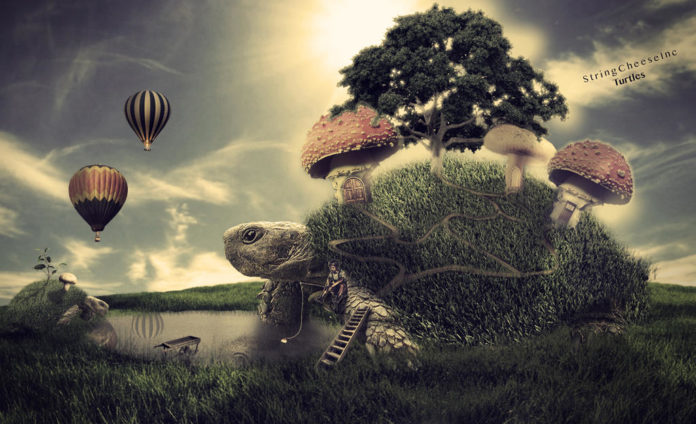The unique string of turtle (peperomia prostrata) is a tiny little Brazilian native semi-succulent that thrives in a climate that mimics the average house. This is why it is featured in houseplant collections and apartment jungles worldwide.
It is a lovely plant popular for the variegated pattern on the surface of its leaves. Due to this variegated pattern, this succulent resembles a turtle and thus is called the string of turtles.
String of turtle is a semi-succulent as it grows in Brazilian rainforests, unlike other succulent which grows in dry areas, but its leaves have the property of storing water which resembles a succulent.
Botanical name: peperomia prostrata
Common name: string of turtles
Plant type: semi-succulent
Mature size: 12 inches
Soil type: loamy and moist
Soil pH: neutral to acidic
Flower color: cream-colored
Native area: Brazil
String of turtle plants is small in size and has a slow growth rate. It reaches its mature stage in three to five years. The leaves of turtle string give this plant a unique name because its tiny leaf has an intricate multi-colored pattern covering the surface.
The color of this plant is dark green and turns brown after reaching the maturity stage, but this little plant never loses its charm. The uniqueness of peperomia prostrata makes it a valuable addition to indoor plants.
Read more- Gift A Beautiful Friendship Plant Or Pilea Plant
Taking care of string of turtle
The proper care of the turtle plant can make it the best indoor plant though the care of the string turtle plant is a little harder as compared to other plants.
Few conditions that affect the growth and health of string of turtle are:
Light
The string of turtle plants needs 7-8 hours of daylight, not direct sunlight, to thrive. Direct exposure to sunlight may damage the leaves.
Though make sure to not leave this plant in direct sun as it may burn.
Soil
The premixes should not be used for growing peperomia prostrata. Instead, organic can be a better option to grow turtle plants. It’s important to maintain the proper pH of the soil. It should not be too high or too low and should be neutral.
Use a pH tester to check the pH of soil from time to time.
Water
After selecting the soil type, sow the turtle plant in it and water it daily.
Water helps in maintaining the moisture of soil which is a must for glowing turtle plants. After it reaches its mature stage, use a soak and dry method.
Temperature and humidity
Peperomia prostrata requires cool weather with humid temperatures. The temperature of the area where you keep your string of turtle plants should be around 68 degrees to 75 degrees Fahrenheit.
During the summers, use a mister or humidifier to ensure that the turtle plant gets enough humidity.
Fertilizer
To maintain the good health and looks of any plant, it is important to feed them with fertilizers.
For feeding turtle plants, you can use houseplant fertilizer two times a week but do not use fertilizers during winters and rainy seasons.
Pruning
When turtle plants if not pruned regularly, they can develop an unkempt, ragged, and leggy appearance. Pruning helps in removing dead leaves and unwanted growth.
It also encourages new flourishes and good growth of turtle plants but make sure to use clean, sharp scissors for pruning.
Pro tips
- The string of turtles is very delicate, so be careful when moving the pot because the leaves can fall off by themselves
- Propagate the leaf after it falls.
- Cut the back of turtle plants in winters.
Tips for propagating peperomia prostrata
Propagating the string of turtles is a very simple process:
- Cut 2-3 inches of stem with leaves attached
- Plant the cuttings in a small pot
- Moist the soil
- Place the pot in an area with a temperature upto 68 degrees Fahrenheit
Read more- Grow A Beautiful Hibiscus Flower In Your Garden
Best uses for string of turtles
String of turtle plants are small in size and ornamental foliage, which make it perfect plant for:
- Terrarium plants
- Hanging baskets
- Dish gardens
- Office desks
- Container gardens
Other best indoor plants
Other than a string of turtle plants, there are other varieties of plants that are becoming popular for the indoor garden. Some of them are:
Snake plant laurentii
Due to the long thin leaves, the name of this plant is snake laurentii. It is very easy to keep snake plant laurentii in the house because it does not require any hard care. they just needs a low light level.
snake plant also filters out nasty chemicals, like benzene, formaldehyde, trichloroethylene, xylene, and toluene present in the environment.
Dracaena gold star
If you have a busy schedule or high-maintenance life, then dracaena gold star is the best plant option for you. It is a low-maintenance plant and just requires water for a healthy life span.
The Dracaena gold star plant also purifies the bacteria present in the air but remember that it is not pet friendly.
Rubber tree
Rubber trees are the best plant for a plant patent or a plant lover. This plant needs 7-8 hours of daylight, not direct sunlight and a big space.
According to the old myths of people, rubber trees create happiness in the house and remove carbon dioxide.
Aloe vera
Almost everyone knows how beneficial aloe vera is; it is also known as a healer plant.
There are numerous benefits of aloe vera. It helps in skin problems, hair problems, sunny problems, removes scars, and many more. Having an aloe vera plant in the house is the most effective way to live a healthy life.
Pothos
Pothos plant is also called cubicle plant. This plant is super easy to grow and propagate as compared to other plants.
The Pothos plant looks like a Chinese money plant because it has oval-shaped leaves with a light green color.
Read more- Benefits of Having Indoor Plants
Final words
Earlier it used to be quite harder to find a string of turtles succulent, as they take a longer time to grow. But nowadays it is available in the market easily. String of turtle is a non-toxic plant and thus is pet friendly.
If you’re a plant lover with your own small garden, then it is time to make a string of turtle plants the member of your little green space.




